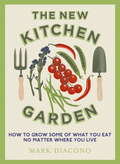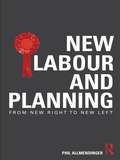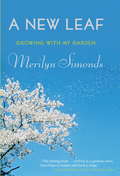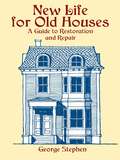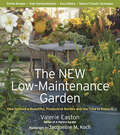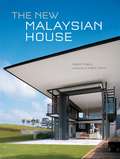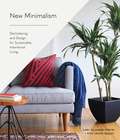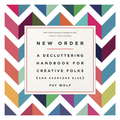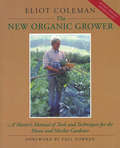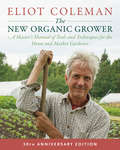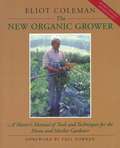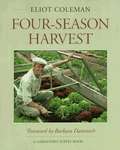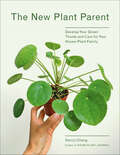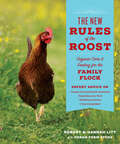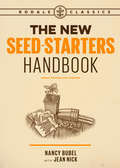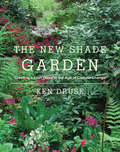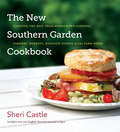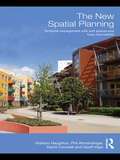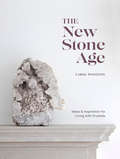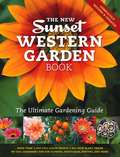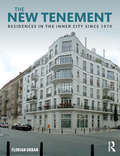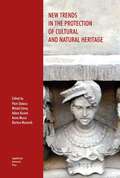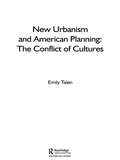- Table View
- List View
The New Kitchen Garden: The Ultimate Kitchen Garden Guide
by Mark DiaconoLook over the fences into the gardens, patios, courtyards and allotments behind, and you'll see a quiet revolution taking place. Amongst the lawns, the roses and the concrete, more and more of us are growing at least some of what we eat. A kitchen garden can be anything from a collection of pots to a small farm - it all depends on where you live and what space you have to create your own edible plot. The New Kitchen Garden doesn't begin with the usual plan of an allotment quartered into beds awaiting their rotation, it starts by asking what you need from your garden. What follows is a series of invitations - fruits, nuts, herbs, spices, flowers and vegetables to grow and eat. Everything is here - the tools, the techniques, the ideas and the knowledge - to enable you to realise that vision of your own kitchen garden. Mark Diacono - who was head of the gardening team at Hugh Fearnley-Whittingstall's River Cottage - captures the spirit of adventure and imagination of those growing food in the twenty-first century. He takes ideas from gardens around the world, including that of his own home, Otter Farm in Devon, with its unique blend of orchards, vineyards, forest gardens, edible hedges, perennial garden and veg patch. Inspired by a range of gardeners growing food on allotments, on rooftops, in container gardens and in other edible spaces, many of them urban, Mark shows you the full exciting breadth of what a kitchen garden can be. Whether you have a few pots of chillies or a community farm, whether you wish to plant in ordered rows or create an edible jungle, The New Kitchen Garden is for you.
The New Kitchen Garden: How to Grow Some of What You Eat No Matter Where You Live
by Mark DiaconoWhether you are taking your first steps in growing some of what you eat, or experienced and looking for inspiration, ideas and some new plants to grow, The New Kitchen Garden is for you. Inspired by a range of gardeners growing food on allotments, on rooftops, in container gardens and in other edible spaces, many of them urban, Mark shows you the full exciting breadth of what a kitchen garden can be. Whether you have a window sill, space for a few plants by the back door, an allotment or an acre, you'll find a series of invitations to grow any of almost 200 fruits, nuts, herbs, spices, flowers and vegetables to suit your space, time and inclination. Everything is here - the tools, the techniques, the ideas and the knowledge - to enable you to realise that vision of your own kitchen garden, wherever you live. There's also a dozen incredible edible gardens - a rooftop food forest, a courtyard of metre-square raised beds, Charles Dowding's no-dig garden, a child's container garden and Raymond Blanc's heritage garden at Le Manoir among them - their gates flung open by the gardeners to reveal their methods, ideas and techniques, with plans, key plants and photography to accompany. Mark Diacono - who was head of the gardening team at Hugh Fearnley-Whittingstall's River Cottage - captures the spirit of adventure and imagination of those growing food in the twenty-first century. He takes ideas from gardens around the world, including that of his own home, Otter Farm in Devon, with its unique blend of orchards, vineyards, forest gardens, edible hedges, perennial garden and veg patch.No matter whether you have space for a collection of pots or a small farm at your disposal, The New Kitchen Garden will show you how to create the most incredible edible garden you can.
New Labour and Planning: From New Right to New Left
by Phil AllmendingerFollowing the Thatcher and Major administrations there was an apparent renaissance of planning under New Labour. After a slow start in which Labour’s view of planning owed more to a neo-liberal, rolled back state model reminiscent of the New Right the Government began to appreciate that many of its wider objectives including economic development, climate change, democratic renewal, social justice and housing affordability intersected with and were critically dependent upon the planning system. A wide range of initiatives, management processes, governance vehicles and policy documents emanated from Government. Planning, like other areas of the public sector, was to be reformed and modernised as well as given a prime role in tackling national, high profile priorities such as increasing housing supply and improving economic competitiveness. Drawing upon an institutionalist framework the book also seeks to understand how and in what circumstances change emerges, either in an evolutionary or punctuated way. It will, for the first time, chart and explore the changing nature of development and planning over the Labour era whilst also stepping back and reflecting upon what such changes mean for planning generally and the likely future trajectories of reform and spatial governance.
A New Leaf
by Merilyn SimondsA graceful and sharply observed book of inspiration that uses the garden as its central museA New Leaf traces a year of growing seasons at The Leaf, Merilyn Simonds' acreage in eastern Ontario. A lifelong gardener, Simonds works the soil and the soul for wide-ranging revelations about everything from flowers that keep time, to the strange gift of compost, to great gardens of the world, to things lost and found underground.She is joined on her journey by a host of companions -- including her Beloved, who tills by her side; the Rosarian, who tends to both bud and thorn in roses and life; and the Frisarian, who weeds unwelcome visitors to make room for new growth. Intelligent and intimate, irreverent and elegant, A New Leaf offers a cornucopia of enrichment and inspiration for the fertile mind.From the Hardcover edition.
New Life for Old Houses: A Guide to Restoration and Repair
by George Stephen"Explains the most important functional and aesthetic design issues, shows how simple design theories can be applied to rehabilitation problems, and describes many of the common pitfalls." -- Library Journal.So you want to put new life into your old house without destroying its special qualities? Then this is the book for you. New Life for Old Houses shows exactly what to do, whether the structure is 50 or 150 years old.Architect George Stephen tells how to select an architect, choose appropriate materials and colors, revive windows, doors, porches, and other details; restore interiors from ceiling to floor; and save energy through simple modifications. An updated edition of a classic handbook, this practical, easy-to-understand introduction to good design and rehabilitation contains 300 illustrations and a valuable glossary of building terms.
The New Low-Maintenance Garden: How to Have a Beautiful, Productive Garden and the Time to Enjoy It
by Valerie Easton Jacqueline Knox Jacqueline M. KochDo you ever lament that you'd love to be able to garden more, but just don't have the time? The demanding pace of modern life leaves little space for the pleasures of gardening. On the other hand, gardening itself could be the culprit: elaborate, traditional perennial borders; water-hungry or disease-prone plants; needy lawns; and high-maintenance plants that require staking or clipping all suck up precious hours. Simply put, we need to start gardening in a whole new way. In this inspiring book, Val Easton shows exactly how to have a low-maintenance garden that doesn't sacrifice style. You won't have to give up your favorite plants or settle for expanses of ugly bark nuggets. You just have to unlearn some bad old habits and pick up some good new ones. So, how do you go about making a "new" low-maintenance garden? First, design your garden with maintenance in mind—good-looking hardscape will both save weeding time and showcase your favorite plants. Second, simplify your garden routines—learn the most efficient planting and maintenance techniques and don't get stressed if everything isn't letter-perfect. Third, learn how to work with nature rather than against it. And finally, embrace home-grown fruits, herbs, and vegetables; well planted containers; and thoughtfully chosen plants.The New Low-Maintenance Garden doesn't just tell you how to garden in a whole new way—it shows you, through profiles and beautiful photographs of real gardens that embody low-maintenance techniques. The pressures of life are not likely to ease up anytime soon, but the lessons of this timely book will help you banish guilt over undone garden chores and revel in your garden successes.
The New Malaysian House
by Robert Powell Albert Lim KsThe New Malaysian House is a collection of 25 contemporary houses that demonstrate a remarkable flowering of Malaysian design talent that has been germinating since the mid- 1980s. The houses range from luxury detached bungalows set in extensive tropical gardens to weekend retreats in the forest, from the gated communities springing up throughout Malaysia to extended family homes. All are distinguished by a singular quality of innovative design as the architects sought to explore new approaches for designing with the climate and in the cultural context of Malaysia.
The New Malaysian House
by Robert Powell Albert Lim KsThe New Malaysian House is a collection of 25 contemporary houses that demonstrate a remarkable flowering of Malaysian design talent that has been germinating since the mid- 1980s. The houses range from luxury detached bungalows set in extensive tropical gardens to weekend retreats in the forest, from the gated communities springing up throughout Malaysia to extended family homes. All are distinguished by a singular quality of innovative design as the architects sought to explore new approaches for designing with the climate and in the cultural context of Malaysia.
New Minimalism: Decluttering and Design for Sustainable, Intentional Living
by Kyle Louise QuiliciThe decluttering craze meets a passion for sustainable living and interior design in this gorgeous new book for readers of The Life-Changing Magic of Tidying Up. This book promises an opportunity for self-reflection and lasting change, by getting to the bottom of why we've accumulated too much stuff in the first place, therefore allowing us to transform our lives. Professional decluttering and design team Cary and Kyle of New Minimalism will take you through every step, from assessing your emotional relationship to your stuff to decluttering your home to then turning it into a beautifully designed space that feels clean and tidy without feeling sparse or prescriptive. And all of this without filling up a landfill--you'll find resources and strategies to donate and reuse your stuff so you don't have to feel guilty about getting rid of it!
New Order
by Fay WolfFor readers of The Life-Changing Magic of Tidying Up and The Power of Habit comes a revelatory, witty guide to a clearer home and a more creative mind. Can a decluttered space fuel a creative mind? Heck yes, says organizing expert Fay Wolf, who has helped everyone from Hollywood celebrities to schoolteachers to work-from-home parents achieve a simpler, more fulfilling life. Here, Wolf outlines her basic rules for saying goodbye to the stuff crowding up your space and hello to new habits that free you up for the things you're passionate about. And it can all be done in as little as a few minutes a day. Learn how to create productive to-do lists * stem the flood of paper * downsize digital clutter and social media * arrange your space to spark creative juices * curb your desire to accumulate * collaborate and connect with others for support * embrace imperfection * keep up the momentum Wolf also shares her favorite productivity apps and resources for donating your many, many items. From the outer clutter of your home to the inner clutter of your chatty mind, this handbook will help you make room for artistic inspiration and invite you to treat yourself to less.
The New Organic Grower
by Eliot ColemanWith more than 45,000 sold since 1988, The New Organic Grower has become a modern classic. In this newly revised and expanded edition, master grower Eliot Coleman continues to present the simplest and most sustainable ways of growing top-quality organic vegetables. Coleman updates practical information on marketing the harvest, on small-scale equipment, and on farming and gardening for the long-term health of the soil. The new book is thoroughly updated, and includes all-new chapters such as:•Farm-Generated Fertility-how to meet your soil-fertility needs from the resources of your own land, even if manure is not available. •The Moveable Feast-how to construct home-garden and commercial-scale greenhouses that can be easily moved to benefit plants and avoid insect and disease build-up. •The Winter Garden-how to plant, harvest, and sell hardy salad crops all winter long from unheated or minimally heated greenhouses. •Pests-how to find "plant-positive" rather than "pest-negative" solutions by growing healthy, naturally resistant plants. •The Information Resource-how and where to learn what you need to know to grow delicious organic vegetables, no matter where you live. Written for the serious gardener or small market farmer, The New Organic Grower proves that, in terms of both efficiency and profitability, smaller can be better.
The New Organic Grower: A Master's Manual of Tools and Techniques for the Home and Market Gardener (30th Anniversary Edition 3rd Edition)
by Eliot ColemanThe Book that Started the Organic Farming Revolution <P><P> Since its original publication in 1989, The New Organic Grower has been one of the most important farming books available, with pioneer Eliot Coleman leading the charge in the organic movement in the United States. Now fully illustrated and updated, this 30th Anniversary Edition is a must-have for any agricultural library. <P> Eliot Coleman’s books and innovative methods have helped innumerable organic farmers build successful farms in deep accordance with nature. The wisdom in this seminal book holds true even as the modern agricultural canon has grown—in large part due to Coleman’s influence as a wise elder with decades of experience. New information has been included in this edition to showcase the new tools and techniques that Eliot has been developing over the last thirty-five years. <P> Inspired by the European intensive growers, The New Organic Grower, 30th Anniversary Edition, offers a very approachable and productive form of farming that has proven to work well for the earth and its stewards for centuries. Gardeners working on 2.5 acres or less will find this book especially useful, as it offers proof that small-scale market growers and serious home gardeners can live good lives close to the land and make a profit at the same time. The New Organic Grower is ideal for young farmers just getting started, or gardeners seeking to expand into a more productive enterprise. <P> New material in this edition includes: <P> Beautiful color photographs throughout, taken by master gardener and author Barbara Damrosch (Eliot’s wife and co-farmer) Updated information throughout on how Eliot’s practices have changed through his experiments over the years A new section from Damrosch about incorporating flowers on the small farm More information on new tools Eliot has invented that don’t appear in any of his other books
The New Organic Grower: A Master's Manual of Tools and Techniques for the Home and Market Gardener
by Eliot ColemanThe simple way to growing top-quality organic vegetables.
The New Organic Grower's Four-Season Harvest: How To Harvest Fresh, Organic Vegetables From Your Home Garden All Year Long
by Eliot ColemanEveryone who grows vegetables must know Coleman. He's the organic methods expert--the one who knows how to maximize both garden yield and gardening pleasure, year round. Annotation c. by Book News, Inc. , Portland, Or.
The New Plant Parent: Develop Your Green Thumb and Care for Your House-Plant Family
by Darryl ChengFor indoor gardeners everywhere, Darryl Cheng offers a new way to grow healthy house plants. He teaches the art of understanding a plant’s needs and giving it a home with the right balance of light, water, and nutrients. After reading Cheng, the indoor gardener will be far less the passive follower of rules for the care of each species and much more the confident, active grower, relying on observation and insight. And in the process, the plant owner becomes a plant lover, bonded to these beautiful living things by a simple love and appreciation of nature. The New Plant Parent covers all of the basics of growing house plants, from finding the right light, to everyday care like watering and fertilizing, to containers, to recommended species. Cheng’s friendly tone, personal stories, and accessible photographs fill his book with the same generous spirit that has made @houseplantjournal, his Instagram account, a popular source of advice and inspiration for thousands of indoor gardeners.
The New Rules of the Roost: Organic Care and Feeding for the Family Flock
by Hannah Litt Robert Litt“The Litts listen daily to concerns and questions posed by customers seeking the best organic methods for keeping backyard chickens safe and healthy. Now they’ve compiled their proven solutions into this often-entertaining book.” —Gail Damerow, author of The Guide to Raising Chickens New from Robert and Hannah Litt—the authors of the bestselling A Chicken in Every Yard—comes a hardworking guide to backyard chicken keeping that goes beyond the basics. The New Rules of the Roost addresses the real problems that crop up when keeping chickens long term. The Litts cover a wide range of topics including organic health remedies and disease prevention, pest management, organic nutrition, the best breeds for specific needs, and the simplest options for daily maintenance and feeding. You'll also learn tips and tricks for introducing new birds into your flock, managing aggressive behavior, caring for mature chickens, and much more.
The New Seed-Starters Handbook (Rodale Organic Gardening)
by Nancy Bubel Jean NickStarting plants from a seed grants earlier harvests, greater variety, healthier seedlings, lower costs, and the undeniable sense of satisfaction and reward. For the most complete, up-to-date information on starting plants from seed, turn to The New Seed-Starter's Handbook. Written by a gardener with 30 years of experience, this updated, easy-to-use reference explains everything you need to know to start seeds and raise healthy seedlings successfully. You'll find:- The latest research in seed starting- The best growing media- The newest gardening materials- Solutions to seed-starting problems- Source lists for seeds and hard-to-find gardening suppliesThe robust encyclopedia section lists more than 200 plants—including vegetables and fruits, garden flowers, wildflowers, herbs, trees, and shrubs—with details on how to start each from seed.
The New Shade Garden: Creating a Lush Oasis in the Age of Climate Change
by Ken DruseThe author of The Natural Shade Garden offers a comprehensive new guide to climate-conscious gardening—beautifully illustrated with 400 photos.There is a new generation of gardeners who are planting gardens not only for their visual beauty but also for their ability to reduce carbon dioxide in the atmosphere. In The New Shade Garden, Ken Druse provides expert advice on creating a shade garden with an emphasis on the adjustments necessary for our changing climate. Druse examines common problems facing today's gardeners, from addressing the deer situation to watering plants without stressing limited resources. Detailing all aspects of the gardening process, The New Shade Garden covers basic topics such as designing your own garden, pruning trees, preparing soil for planting, and the vast array of flowers and greenery that grow best in the shade. Perfect for new and seasoned gardeners alike, this encyclopedic manual provides all the information you need to start or improve upon your own shade garden.
The New Southern Garden Cookbook: Enjoying the Best from Homegrown Gardens, Farmers' Markets, Roadside Stands, and CSA Farm Boxes
by Sheri CastleIn The New Southern Garden Cookbook, Sheri Castle aims to make "what's in season" the answer to "what's for dinner?" This timely cookbook, with dishes for omnivores and vegetarians alike, celebrates and promotes delicious, healthful homemade meals centered on the diverse array of seasonal fruits and vegetables grown in the South, and in most of the rest of the nation as well. Increased attention to the health benefits and environmental advantages of eating locally, Castle notes, is inspiring Americans to partake of the garden by raising their own kitchen plots, visiting area farmers' markets and pick-your-own farms, and signing up for CSA (Community Supported Agriculture) boxes from local growers. The New Southern Garden Cookbook offers over 300 brightly flavored recipes that will inspire beginning and experienced cooks, southern or otherwise, to take advantage of seasonal delights. Castle has organized the cookbook alphabetically by type of vegetable or fruit, building on the premise that when cooking with fresh produce, the ingredient, not the recipe, is the wiser starting point. While some dishes are inspired by traditional southern recipes, many reveal the goodness of gardens in new, contemporary ways. Peppered with tips, hints, and great stories, these pages make for good food and a good read.
The New Spatial Planning: Territorial Management with Soft Spaces and Fuzzy Boundaries
by Graham Haughton Philip Allmendinger David Counsell Geoff VigarSpatial planning, strongly advocated by government and the profession, is intended to be more holistic, more strategic, more inclusive, more integrative and more attuned to sustainable development than previous approaches. In what the authors refer to as the New Spatial Planning, there is a fairly rapidly evolving maturity and sophistication in how strategies are developed and produced. Crucially, the authors argue that the reworked boundaries of spatial planning means that to understand it we need to look as much outside the formal system of practices of ‘planning’ as within it. Using a rich empirical resource base, this book takes a critical look at recent practices to see whether the new spatial planning is having the kinds of impacts its advocates would wish. Contributing to theoretical debates in planning, state restructuring and governance, it also outlines and critiques the contemporary practice of spatial planning. This book will have a place on the shelves of researchers and students interested in urban/regional studies, politics and planning studies.
The New Stone Age: Ideas and Inspiration for Living with Crystals
by Carol WooltonA fashion-forward guide to living well with crystals from the jewelry editor of British Vogue—including guidance and advice from designers, jewelers, and celebrity crystal fans.The New Stone Age guides you through fifteen different types of stones, categorized by color, and teaches you how to stylishly incorporate them into your wardrobe, home, and beyond. Assigning each crystal to a particular ailment of the modern age, whether it&’s self-doubt, travel anxiety, or restlessness, Carol Woolton explains how a simple crystal worn around your neck, tossed in your purse, or sitting next to your computer can help inspire you to make positive changes in your life. Woolton traces the history of crystals, showing how the same quartz that was used as a form of protection in the handles of Egyptian daggers can also be hung near a bedside to help with burnout. Filled with insights, facts, and real-life stories from people who attribute dramatic personal improvements to their crystals, The New Stone Age is a fun and informative idea book for crystal lovers everywhere.
The New Sunset Western Garden Book: The Ultimate Gardening Guide (Ninth Edition)
by Kathleen Norris BrenzelThis book is an indispensable reference for beginning and expert gardeners alike. Completely redesigned and updated, this ninth edition includes a fresh new look, thousands of color photographs, fresh illustrations, and an easy-to-follow format.
The New Tenement: Residences in the Inner City Since 1970
by Florian UrbanThis book examines "new tenements"—dense, medium-rise, multi-storey residences that have been the backbone of European inner-city regeneration since the 1970s and came with a new positive view on urban living. Focusing principally on Berlin, Copenhagen, Glasgow, Rotterdam, and Vienna, it relates architectural design to an evolving intellectual framework that mixed anti-modernist criticism with nostalgic images and strategic goals, and absorbed ideas about the city as a generator of creativity, locale of democratic debate, and object of personal identification.This book analyses new tenements in the context of the post-functionalist city and its mixed-use neighbourhoods, redeveloped industrial sites and regenerated waterfronts. It demonstrates that these buildings are both generators and outcome of an urban environment characterised by information exchange rather than industrial production, individual expression rather than mass culture, visible history rather than comprehensive renewal, and conspicuous difference rather than egalitarianism. It also shows that new tenements evolved under a welfare state that all over Europe has come under pressure, but still to a certain degree balances and controls heterogeneity and economic disparities.
New Trends in the Protection of Cultural and Natural Heritage
by Piotr Dobosz, Witold Górny, Adam Kozień, Anna Mazur, Bartosz MazurekThe book entitled New Trends in the Protection of Cultural and Natural Heritage is a collection of twelve scientific articles (chapters) authored by Polish and foreign researchers in the field of cultural heritage protection. Specializing in various scientific disciplines (including legal, architectural, managerial, cultural studies considerations) and at different stages of scientific development, the authors of the individual texts from either a casuistic (case studies) or systemic (studies of normative solutions or development trends) perspective analyze new trends in the protection of cultural and natural heritage.
New Urbanism and American Planning: The Conflict of Cultures (Planning, History and Environment Series)
by Emily TalenNew Urbanism and American Planning presents the history of American planners’ quest for good cities and shows how New Urbanism is a culmination of ideas that have been evolving since the nineteenth century. In her survey of the last hundred or so years of urbanist ideals, Emily Talen identifies four approaches to city-making, which she terms ‘cultures’: incrementalism, plan-making, planned communities, and regionalism. She shows how these cultures connect, overlap, and conflict and how most of the ideas about building better settlements are recurrent. In the first part of the book Talen sets her theoretical framework and in the second part provides detailed analysis of her four ‘cultures’.She concludes with an assessment of the successes and failures of the four cultures and the need to integrate these ideas as a means to promoting good urbanism in America.
